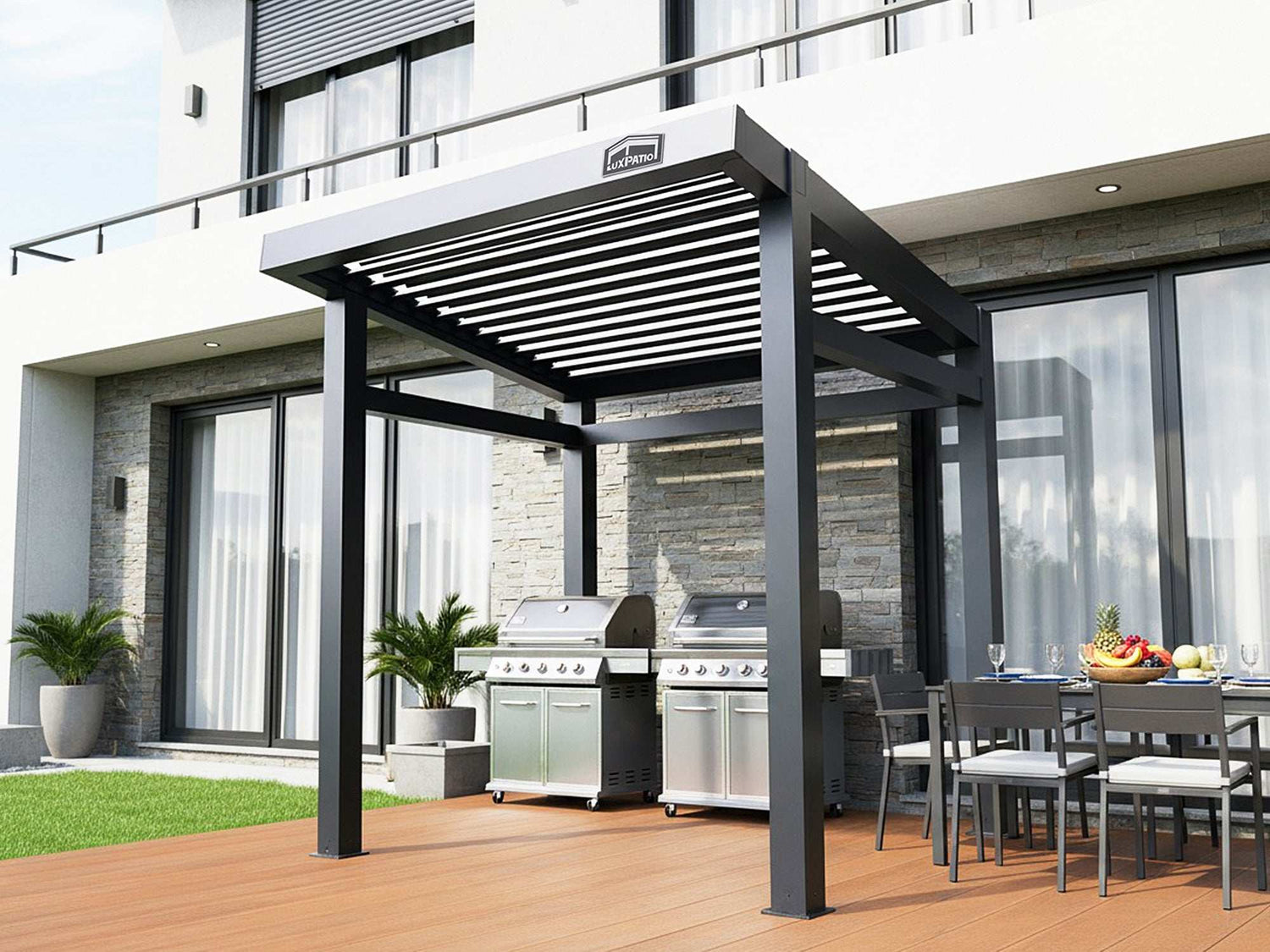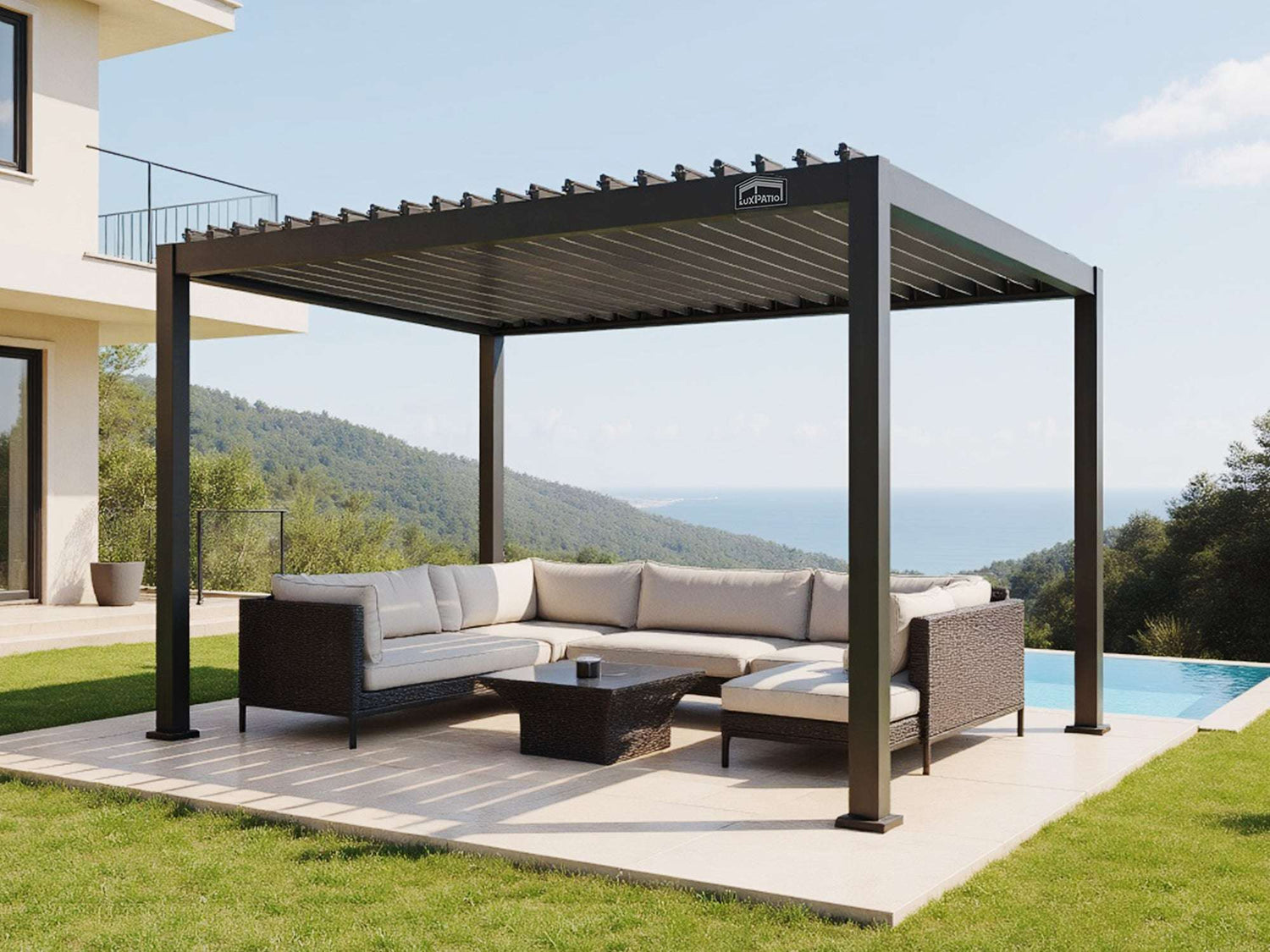You want a patio that stays pleasant at noon, not a space you abandon when glare climbs. The real question is simple: do pergolas provide real shade or only pretty stripes on the ground? Results depend on roof type, placement, and the add-ons you choose. A classic slatted frame softens light and keeps air moving. A louvered pergola shade structure goes further by letting you tune light, airflow, and even rain protection as conditions change. Plan those choices correctly and pergola shade becomes reliable comfort.
Benefits of Pergola Shade
Good shade changes behavior. People linger, conversations flow, and screens become readable without squinting. There is also a health angle. Fabrics and screens with a tested UPF rating give predictable ultraviolet reduction. A UPF 50 label means only one fiftieth of UV reaches the skin, which is about 98% blocked. That single number helps you judge canopies and side blinds with confidence instead of guessing from vague "shade percent" claims.
Shade also supports the rooms inside. When a structure knocks down afternoon sun on nearby glazing, peak heat gains drop and indoor temperature stays steadier. Adjacent living rooms feel calmer on bright days, and you rely less on blinds and artificial lighting.
A final win is durability. Cushions fade more slowly, finishes keep their sheen, and decking avoids the baked look that arrives after long seasons of unfiltered sun. That is pergola shade working all day, not just in staged photos.

How Much Pergola Shade Does a Traditional Pergola Provide?
A traditional pergola with fixed rafters and purlins gives partial shade. Midday light slips between slats unless spacing is tight, so you get a moving pattern rather than deep cover. The bigger issue arrives at breakfast and late afternoon. East and west sun rides low, slides under the roof line, and lights faces at dining height. Horizontal overhangs are excellent at blocking high sun and much less effective against low angles near the horizon.
So does a classic frame fail. It builds structure, supports vines, and improves privacy. It just needs help if your main goal is a pergola for shade through lunch and into the early evening. In that case, plan an adjustable top layer, a vertical layer on the worst side, or both. With that combination, the same pergola flips from decorative to dependable.
How Louvered Pergolas Offer Total Pergola Shade Control
Tilting blades turn static slats into a controllable roof. Open for sky and breeze. Angle to mute glare. Close before a shower and keep the table dry. This flexibility matters because eastern and western exposure changes minute by minute, while noon is a different problem entirely. Adjustable external shading is especially helpful for those low angles, and a louvered pergola shade structure delivers that adjustment without blocking airflow.
Mechanically, the idea is simple. As the louvers close, interlocking edges form a surface that channels water into built-in gutters and down through posts, so ordinary rain does not end the meal. Water leaves through the base instead of dripping through gaps over the seating area. That is why tilting roofs often replace improvised tarps and temporary covers on patios that see mixed weather.
A few usage tips make the most of this type of pergola shade:
- Set blade direction based on your prime hour. A slight tilt can erase western glare at dinner while keeping a slice of sky in view.
- Combine a single side screen with the tilting roof if your site faces long, low light in the evening. Vertical control handles horizon rays far better than thicker rafters ever can.
With these small decisions, the roof becomes a daily tool rather than a static decoration.

Pergola Placement & Orientation: Maximizing Shade by Sun Position
Placement decides how often you touch the controls. Before ordering, spend a week watching the patio between 11 a.m. and 6 p.m. Note where light strikes eyes and tabletops at your usual seating times.
A few rules help nearly every backyard:
Read the Low-Angle Pattern
Morning and evening rays come from the horizon, so they slide below horizontal overhangs. Adjustable vertical shading on the east and west sides handles this better than any roof extension. Keep the top for midday sun, and assign screens, blinds, or lattice panels to the horizon problem.
Use Orientation to Your Advantage
Think about where the harshest light comes from during your favorite hours outside. Rotate the pergola so its longest side protects that direction, then set the louver direction to respond with small angle changes. When form and sun path cooperate, you need fewer accessories to get comfortable pergola shade.
Let Plants Assist
Climbers on trellis panels create seasonal side shade, thicker in summer and lighter in winter. They soften the wind and reflect less heat than paving, which makes the seating zone feel calmer. A planted panel on the bright side often replaces a second screen.
Protect the Room Behind You
A few feet of late-day shade on sliders or large windows cuts indoor glare and afternoon heat spikes. The room you step back into feels less washed out, the air conditioner cycles less frequently, and you keep the views open instead of pulling the blinds.
All of this takes a notebook, a compass app, and a few evenings of attention. The payoff is a pergola that works with the sun rather than fighting it.
Pergola Shade Solutions: Choosing the Right Option for Your Needs
Different sites call for different tools. Use the table to see how common choices stack up, then look at the notes that follow.
| Solution | What it solves | UV signal to look for | Rain handling | Airflow | Upkeep | Good fit |
| Tilting louvered roof | Noon glare, late-day horizon light, ordinary showers | Depends on angle; closed blades create deep shade | Interlocking blades route water to integrated gutters and down posts | Adjustable with blade angle | Rinse, hinge checks | Year-round dining and mixed-weather comfort |
| UPF-rated canopy | Skin safety, glare control with light feel | UPF 50 ≈ 98% UV blocked | Only if fabric is rated for rain | High | Clean fabric, inspect hardware | Families seeking predictable UV control and easy operation |
| Vertical screens or blinds | East and west low-angle sun, privacy | Choose fabrics with stated UV performance | Blocks wind-driven rain partially | Moderate to high, depending on weave | Wipe down, check cords | Patios that glow at dinner time and need horizon control |
| Polycarbonate panels | All-weather clarity, dry seating | Look for manufacturer UV block data | Solid rain roof by nature | Lower than open roofs | Wash sheets, check seals | Cooler seasons, windy sites, or all-weather zones |
| Pergola sun shade sail or net | Seasonal projects, budget control | Prefer products that list UV, not only "shade percent" | Porous versions shed light rain | High | Tension checks | Quick relief for summer and rental situations |
Here is how to apply the matrix without overthinking it.
If your top frustration is afternoon glare and surprise showers, a tilting roof covers both with one control. You nudge the louvers to manage the sun, then close them when clouds roll in. Water moves through the integrated gutters, and the table stays dry.
If UV exposure is the main driver for kids and sensitive skin, let UPF labels guide choices. A UPF 50 canopy or side screen means roughly 98% of ultraviolet is blocked. That is more reliable than generic "shade percentage" claims, which often describe visible light rather than UV.
If breakfast, sun, and after-work light dominate, add a single side screen on the worst exposure. Adjustable vertical elements work best for those angles, so one well-placed screen plus an ordinary roof often beats a much heavier frame.
If you want clarity and a dry table in shoulder seasons, consider polycarbonate sheets with documented UV protection. Properly made panels block nearly all harmful ultraviolet while still passing visible light. Airflow is lower than with open rafters, so think about pairing this roof with a ceiling fan or keeping some sides fully open.
For seasonal or budget projects, a pergola sun shade sail sized to the frame and tensioned correctly can transform the feel of the space for summer. Just make sure the product lists UV performance, not only marketing phrases about "cooler shade."
A simple planning checklist keeps the decision honest:
- Which hours will you actually sit outside in summer
- Which horizon produces the harshest light at that time
- Do you need a dry table during ordinary rain, or only UV and glare control
- Is a single-side screen enough once the top is adjustable
Answering those questions gets you most of the way to the right mix of pergola shade tools.

Build Pergola Shade Around Your Climate and Routine
The opening question has a clear outcome. Pergolas can provide real shade. A traditional frame offers partial relief and a welcoming ceiling of light. A tilting roof brings dependable pergola shade at noon and near sunset, then keeps the table dry during short showers by routing water into hidden gutters. Vertical screens solve the horizon light that horizontal overhangs miss. UPF-rated fabrics set a trustworthy floor for ultraviolet control, and clear panels extend use through wet months.
Place the structure so it works with the sun path you actually live with, size controls to your favorite hours outside, and your patio becomes a room you choose, not a space you escape. Combine an adjustable roof with at least one vertical device on the bright side, and you give that pergola for shade everything it needs to stay comfortable through the year.
FAQs
Q1. Do I need a building permit for a pergola shade structure?
Many areas treat permanent pergola shade structures like small accessory buildings. If posts are anchored to footings, attached to the house, or carry a solid or louvered roof, local code may require permits, setbacks and engineered loads. Always confirm rules before ordering materials.
Q2. How often should I maintain a louvered pergola for shade?
Louvered pergola shade systems benefit from seasonal care. At least once or twice a year, rinse blades and gutters, clear debris from posts, check seals, and lightly lubricate moving parts if the manufacturer recommends it. Regular care prevents binding, noise, and drainage issues.
Q3. Can pergola shade make my patio feel too hot in summer?
Any covered pergola shade setup traps some warm air. To keep the space comfortable, favor light-colored finishes, keep at least two sides open, and consider a ceiling fan rated for damp or wet locations. Good cross-ventilation matters as much as roof choice.
Q4. Is it safe to add lights, fans, or heaters to a pergola shade setup?
Yes, many homeowners integrate low-voltage lighting, heaters, and fans into pergola shade designs. Plan conduit runs and junction boxes before pouring footings, use weather-rated fixtures and wiring, and give heaters their own circuits. A licensed electrician should connect anything tied into the main panel.
Q5. Does adding pergola shade increase my home's resale appeal?
Thoughtful pergola shade can improve perceived home value in several ways. It makes outdoor space feel like an extra room, supports entertaining, and photographs well for listings. Buyers often see a well-designed shaded patio as a lifestyle upgrade that differentiates your property.










